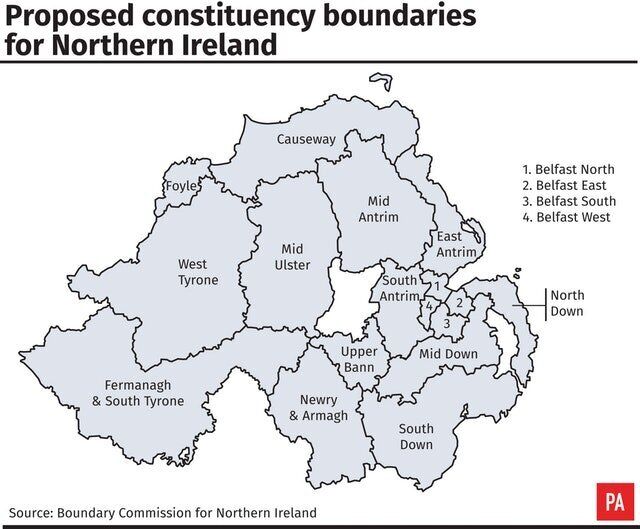A plan to redraw electoral boundaries in Northern Ireland has been significantly altered, with Belfast now set to retain its four seats, according to an official map obtained by the Press Association.
The map titled “2018 revised proposals” was briefly accessible on a section of the Boundary Commission for Northern Ireland website earlier this week. While it has since been deleted, PA has secured a screenshot of the map.
The commission has confirmed the map temporarily went live during a test exercise.

(PA Graphics)
Northern Ireland is losing one constituency as part of wider government plans to reduce the number of seats in the UK from 650 to 600. How the reduction from 18 to 17 seats is achieved has become the source of political controversy.
The commission’s first proposals, published in 2016, were heavily criticised by the Government’s kingmakers, the Democratic Unionists, who claimed it could undermine the political stability of the region.
Analysts suggested the first version would see the DUP lose a seat to Sinn Fein in Belfast.
That map saw Belfast drop from four constituencies to three with the redrawing of a number of boundaries elsewhere in the region.
It envisaged the creation of a series of new constituencies – North Tyrone; Glenshane; Dalriada; West Antrim; Upper Bann and Blackwater; and West Down – by merging parts of existing constituencies.
But the revised map that was accessible on the commission website on Monday is significantly different.
Belfast retains its four seats, with radical changes to the constituency landscape beyond the city. All the new named constituencies in the first draft are gone.
The commission, which is an independent body funded by the Northern Ireland Office, has conducted a number of public consultation exercises on its first proposals and is anticipated to officially publish revised proposals at the end of the month.
The map that briefly went public on Monday envisages the creation of a Causeway constituency on the north coast, merging part of East Londonderry with part of North Antrim and a small section of East Antrim.
The remainder of North Antrim is renamed Mid Antrim and takes in parts of East Antrim and South Antrim.
South Antrim, in turn, takes part of a defunct Lagan Valley. Another portion of Lagan Valley merges with a section of Strangford, and a small part of South Down, to become Mid Down.
South Belfast is also expanded to take in parts of Lagan Valley and Strangford. Like Lagan Valley, the Strangford name is gone. The remaining chunk of the constituency is absorbed into a significantly larger North Down.
The remaining parts of East Londonderry are absorbed by enlarged West Tyrone and Mid Ulster constituencies.
Unlike the expansion proposed under the first draft, Fermanagh and South Tyrone remains largely unchanged.
The map has come to light amid on-going speculation that the wider UK 2018 boundary review could be scrapped.
Labour has opposed the plan, with the party standing to lose seats under new boundaries, and some Tory backbenchers are also unhappy with the proposal to cut the number of MPs to 600.
Last week the Commons Public Administration and Constitutional Affairs Select Committee heard evidence about the implications of scrapping the review.
The final proposals are due to go to the Government in September. Once they are laid before Parliament, MPs can approve or reject them.
Current Sinn Fein MP for Mid Ulster, Francie Molloy, has said the revised electoral boundary map would amount to government gerrymandering to placate the DUP.
“The Boundary Commission proposed and consulted on new electoral boundaries in 2016 as part of an overall plan to reduce the number of MPs here from 18 to 17,” he said.
“Unsurprisingly, the DUP rejected the plan despite the fact that the proposals reflected the terms and remit under which the Boundary Commission was established.
“Sinn Fein warned at the time that any attempt via the Tory-DUP pact to subvert this process would represent an anti-democratic attempt to gerrymander electoral boundaries in that party’s favour.
“These new proposals will also impact upon electoral boundaries for Assembly elections, ensuring gerrymandered constituencies reminiscent of those drawn up by the unionist one-party state decades ago.
“The Boundary Commission should immediately clarify whether the media reports of the amended proposals are accurate because, if they are, it would mean that the Tories have again acquiesced to the DUP’s anti-democratic agenda, just as they have done on issues such as equal marriage, the Irish language and legacy inquests.
“That is entirely unacceptable and further evidence of the British Government’s ongoing refusal to act in an impartial manner as they are obliged to under the terms of the Good Friday Agreement.”
Elections expert Nicholas Whyte, visiting professor at Ulster University, highlighted that the DUP “were not the only people who opposed” the reduction from four to three seats in Belfast – the SDLP and others had done so too.
Mr Whyte said during the consultations on the commission’s original proposals he had come to the view that retaining four seats in Belfast was feasible, whereas previously he had thought three seats would be necessary to achieve the overall reduction in Northern Ireland seats from 18 to 17.
The elections analyst, who earlier said on twitter the revised plans seemed to be “not too far off my own proposals”, praised the new map as “much better” than that for the original proposals.
However, he said he doubted the plans ever would be implemented.
“I still don’t see the parliamentary arithmetic is there to pass these proposals,” he added.
A spokesman for the Boundary Commission for Northern Ireland told PA: “During the preparation for our Revised Proposal consultation, which begins on 30 January 2018, the functionality of the website was being tested including the interactive map facility.
“The interactive map facility was accessed during this testing phase.
“The commission will be proceeding with the Revised Consultation on 30 January as planned.”